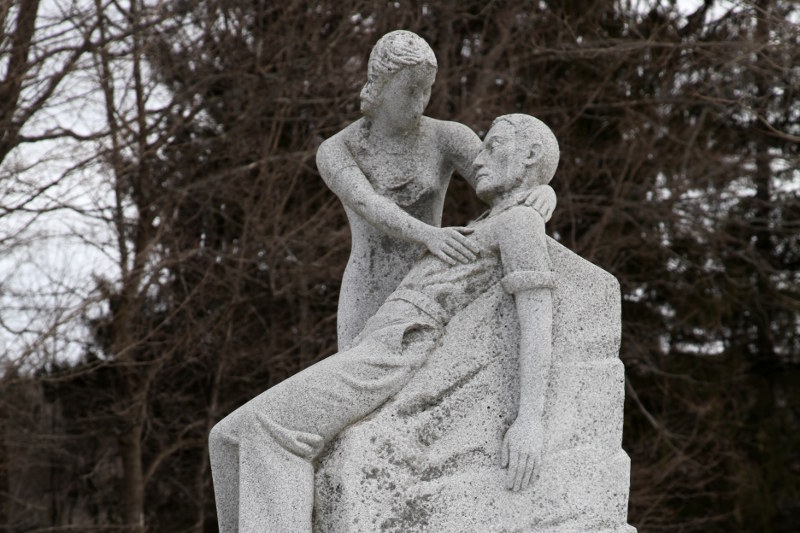Vermont is a major player in the world’s granite market. Just outside the town of Barre is the rather famous Rock of Ages quarry… this is the same quarry that a young Captain Kirk launched his step-father’s car off a cliff during the first Star Trek remake movie in 2008.
A plethora of locally available granite means that in Barre there’ll be a glut of statues and headstones because it’s affordable for people to take advantage of the raw materials and artisan talent; so, we predicted that the graveyards in Barre were going to be photographic eye candy.
The Hope Cemetery does not disappoint; you could easily meander for hours and hours to see what the locals have created. Many headstones are unique and were designed to show something from the deceased person’s life.
A number of these headstones have sad stories to go with them; this is ironically true of Elia Corti, who was a partner, gifted sculptor, and stone cutter for one of the largest monument manufacturers in the United States: Novelli & Corti. He became an unwilling victim to what the papers described as the “Granite Street fracas.”
It was a heated time in the granite community. After the Civil War, the United States saw a major influx of European immigrants between 1880-1920. The town of Barre received families from Italy who brought knowledge of sculpting and stone cutting with them. Unfortunately, their working conditions were no better than slavery and they were often targets for oppression and harassment.
To the North, in Hardwick, workers were on strike demanding an 8-hour workday, better working conditions, and higher pay. The Lumpers and Drillers Union [link removed] was working overtime to push the “granite bosses” towards a resolution.
In Barre, the Anarchist movement was well underway; the town was a home for many European workers from Scotland, Spain, and Italy and with them, they brought a desire for freedom of thought and the idea of stateless societies where no man rules over another.
Elia Court was one of the first Italian migrants and anarchists to move to the community in 1891. It was twelve years later when he was shot during a meeting in the Socialist Labor Party Hall on Granite Street. The building was a frequent location for discussions between “anarchists, socialists, and union leaders over the future direction of the labour movement in the United States.” (Wikipedia)
“Eli Corti, junior member of the granite statuary cutting firm of Novelli & Corti, was shot in the stomach and mortally wounded at a meeting in the socialist building on Granite Street Saturday evening… Corti died at midnight last night at Heaton Hospital, Montpelier, having lived about 30 hours after he received the bullet. The shooting occurred at 7:15 o’clock Saturday evening and was the outcome of a general discussion between socialist and anarchists present.” – Barre Daily Times (October 5, 1903)
Andrew Garretto was arrested, charged, jailed, and tried for the incident. Corti identified the shooter in the ambulance (and repeatedly until his death). Italian newspapers claim it was an assassination attempt by the Socialists. The socialists claim the murder was justified. Garretto himself claimed that he, “egli nega la colpabilità ammettendo d’aver agita in istato di legittima d fesa” (acted in self defense).
The court case was pretty cut-and-dry: Garretto bought the ammunition ahead of the meeting. There were 28-witnesses who saw Garretto sitting at the back of the hall just before he shot Corti from across the aisle. The doctor testified that two meeting attendees were shot that night: Corti and a second man named Emilio Vochini who was not killed but had a bullet lodged in his hand and armpit.
Garretto later turned up at the police station with his pockets full of ammunition but with no gun. Apparently, the gun was taken by meeting attendees who beat him up after the shooting.
Garretto claimed he and another man were attacked at the meeting but witnesses stated: “Presso alla porta dov’era Garretto tutto era tranquillo. Non ha visto alcuno percuotere il Bernasconi, nò il Garretto, riconfermando che presso la porta dove stava Garretto tutto era tranquillo.” (Near the door where Garretto was, everything was quiet. He did not see anyone hit the Bernasconi, nor the Garretto, reconfirming that at the door where Garretto was standing everything was quiet.)
After his death, it was Elia’s brother (William Corti) and brother-in-law (John Comi) who carved Eli’s headstone. It was sculpted out of one flawless, solid piece of granite.
When he was released from jail, Andrew Garetto was no longer able to live in the community. He dropped out of sight and it’s believed he went back to Italy to live, just in time for the Great War.
